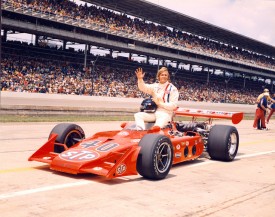In the build up to the 2014 Indianapolis 500, The Checkered Flag is looking back on significant races that have contributed to the glorious history of the 97 500s that have been and gone.
—————–
Three days after the green flag fell for the 57th Indy 500, Gordon Johncock would be declared winner of a race that would not be remembered for his success but for the string of incidents and fatalities that have labelled the 1973 race jinxed.
It was important to remember that this 500 was held in an era still very dangerous for single seater racers of all creeds, be it USAC (the precursor to IndyCar) or Formula One. Two years previously Jo Siffert died in an avoidable tragedy at Brands Hatch, and in the very same year as this jinxed 500, both Roger Williamson and Francois Cevert would lose their lives behind the wheel.

Swede Savage with his Eagle-Offenhauser (Credit: IndyCar Media)
Before the USAC field even got to Indiana, another driver in the field – Bob Criss – died at a private test at Phoenix. This race, it seemed, bucked the trend for fatalities in single seater racing as this three day 500 would claim the lives of drivers Art Pollard and Swede Savage, as well as a member of the pit crew – Armando Teran.
Prior to the race the entire Month of May was afflicted with bad weather, there were six days that were either rained off entirely or saw a lot of their running curtailed – and that was just before Bump Day.
It wasn’t just the weather that affected the field, one year earlier the championship had allowed teams to affix bolt on wings to their machines. This would see cars touching the 200mph barrier without safety aids that improved at the same rate the speed did, this was coupled with a turbocharged I-4 Offenhauser engine that could hit 1,100HP in qualifying trim and provide wheelspin that even Mario Andretti called scary.
Prior to the first day of qualifying most of the field had avoided major scrapes, there were a handful of cars hitting the wall but no serious injuries were reported.
That all changed on the day of qualifying. Art Pollard hit the wall on the outside of turn one sending the car into a flip as well as bursting into flames, suffering from burns over the majority of his body. He was declared dead an hour later at the Methodist Hospital of Indiana.
When all was said and done in qualifying, Johnny Rutherford secured pole position with Bobby Unser next to him and Mark Donohue was positioned on the outside of the front row.
The race was meant to start on May 28th, but an 11 car crash began before the field have even reached turn one at the start of he first lap. Trying to find space approaching the turn Salt Walther was spun and flipped into the catch fence, showering sections of the crowd with burning fuel as it ripped Walther’s car apart. The wreck came to rest upside down on the apron at the bottom of turn one, Walther’s legs exposed. Miraculously Walther, though seriously injured, survived and would return to race again at the Speedway. In the wake of the accident the race was red flagged, and with rain falling during the delay the restart was pushed back to the following day.
That day – Tuesday – came and went without so much as a whimper, cars that had suffered damage the day before were allowed to be repaired and restart in the original grid based on qualifying times. However, as the pace car went round it began to rain – again – and the race was yet again red flagged.
Wednesday had arrived and the race – labelled the 72 Hours of Indianapolis – had taken its toll on the field, many of the spectators had long since given up on the race and pole sitter Rutherford was reported as saying that many drivers would have voted to move on to Milwaukee if they had been asked.
Thankfully it appeared that the race had settled down, there were no very serious accidents but nine cars had retired before the 50 lap mark with numerous mechanical issues and a crash for Peter Revson.
However, the big incident occurred on lap 57. Just two laps earlier Swede Savage had pitted his STP sponsored Eagle-Offenhauser from the lead to take on 70 gallons of fuel and a new right rear tyre.
On lap 57 Savage exited turn four and appeared to lose control of the car, it then hit the angled wall to the inside of the track with such a force that the fuel inside the car exploded literally ripping the car apart sending bolts, engine and fuel across the track. Savage – conscious and still strapped into his seat – was also flung across the track to come to rest back against the outside wall. Track workers quickly set about extinguishing the invisible flames of the fuel fire around him as the race was once more halted by a red flag.
In the aftermath of this, Armando Teran – who was the pit board man for Savage’s team Patrick Racing – ran down the pit lane to get to the crash scene. He was hit by a fire engine travelling to Savage’s rescue, moving in the same direction up the pit lane, he died almost immediately in the pits.
As the race got back underway George Snider, who witnessed the crash, handed his car over to team boss A.J. Foyt who retired his own car earlier in the race. After 133 laps, the rain fell yet again and the race was finally called to an end with Johncock declared winner of a race that saw just ten finishers.
A month after the race the ‘jinxed’ 500 had one last cruel hand to play. Savage was making a steady recovery from the injuries he sustained in his accident. However, a contaminated blood transfusion led to him contracting the Hepatitis B that would claim his life. To date he remains – thankfully – the last driver to lose his life after a race day accident.

Rutherford would score pole in his McLaren (Credit: IndyCar Media)
The following year saw a raft of changes in a bid to make the cars safer, fuel tanks were near enough halved in size as were the bolt on wings. The wall on the inside of turn four was removed and better crash fences were installed with spectators pushed back away from the track.
For Gordon Johncock, he would have a second Indy 500 win in 1982, holding off Rick Mears to claim a well remembered victory for all the right reasons – his winning margin was only 0.16 seconds.
www.theCheckeredFlag.co.uk will be providing full coverage of the 98th Indy 500 both on Twitter at @TheCheckerFlag as well as here on the website.



